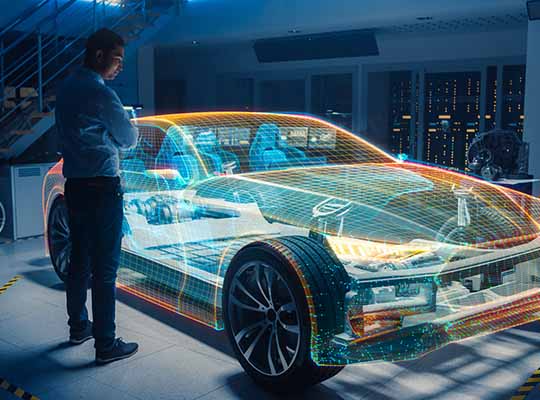SHANGHAI – Cango Inc. (“Cango”) is issuing a bi-monthly industry insight publication called “CANGO Auto View” to bring readers, drivers and passengers up to speed on the automobile market’s emerging trends.
Below is an article from the Company’s 5th edition for September 2021.
A new sales model for new energy vehicles (NEVs)
Traditionally, automobile manufacturers produce cars and sell them wholesale to dealers, who conduct retail sales to end consumers as well as after-sales services through independent 4S stores. As a new generation of Internet-savvy consumers drives demand and trends like electrification and auto intelligence become more popular, an increasing number of automakers have started to adopt a direct sales model, wherein consumers order cars directly from the manufacturer’s website for delivery or local pickup at a manufacturer-operated showroom or “experience center.” Prices are unified regardless of region, and rebate-enabled or other dealer discounts are not available. Tesla, a U.S. automaker and market leader, was the first to disrupt the traditional sales process by adopting a direct sales model.
Competition for new consumption scenarios
In addition to competing in areas like technology and capital, many new car brands have followed Tesla’s example and opened car experience centers in large shopping malls and other high foot traffic areas, making shopping malls an important NEV brand battlefield. 4S stores traditionally operate in suburban locations, far away from the city center, to offer a large area for car maintenance. In contrast, according to the “Report on the Development of China’s Automobile Sales Channels in 2020,” the current proportion of urban showrooms for NEV brands is about 65%, and they tend to select large shopping malls or office buildings in city centers. Sales centers in particular are located in large shopping centers in bustling downtown areas. Data has also shown that separating sales and after-sales services is key for NEV brands. Tesla mainly operates its after-sales service centers in China through the authorization model by cooperating with third-party repair and maintenance service centers.
According to a third-party survey, as of April 2021, Tesla, NIO, XPeng, and Li Auto had 87, 131, 125, and 57 stores respectively in the surveyed shopping malls. The top three cities in terms of the number of NEV stores are Shanghai, Hangzhou, and Shenzhen, all of which are mega cities with “car purchase restrictions and license restrictions.” Among them, Shanghai hosts the richest portfolio of NEV brands. The Shanghai West Nanjing Road business district alone hosts Tesla, NIO and XPeng experience stores.
There are numerous possible explanations for this trend. NEV automakers need to increase brand awareness, and shopping malls, known as “offline traffic aggregators,” attract high-value foot traffic that can draw the consumers closer to brands, expand brands’ exposure, and enhance brand image. NEVs are also relatively new to the market and mainly appeal to consumers aged 25 to 40, who have a great deal of spending power, are willing to try new things, and value excellent customer service and consumption quality.
Given the various benefits of opening stores at shopping centers, traditional car companies including BYD, BAIC, SAIC and Dongfeng, have also begun to compete for space in high-quality business districts.
Disadvantages of the direct sales model
There are also downsides to NEVs’ direct sales model, including the cost of renting high-quality, high-traffic retail space. According to the media, the annual rent for XPeng’s flagship experience center in Sanlitun, Beijing, with a floor area of nearly 500 square meters, is about 10 million yuan. NIO’s showroom in Wangfujing, Beijing, occupying 3,000 square meters, costs as much as 70-80 million yuan per year.
Because auto industry players are typically well-capitalized, their demand for space caused rents in shopping malls to rise dramatically, negatively affecting tenants in catering, apparel and other businesses with less backing from the capital market. However, industry insiders generally believe that the practice of opening stores in shopping centers is only temporary. Currently, new brands lack brand awareness and customer base, and must choose store locations with the largest potential audience to build their brand. Once new brands establish their reputation and fan base, they will eventually return to more traditional auto business areas, building larger service centers that customers visit only when service is required.
Explosive growth of NEV sales presents another challenge for the direct sales model. If the current growth momentum in NEV sales continues, sales of NEV brands may reach 200,000 to 300,000 cars annually. This sales volume requires a huge team for direct operation, increasing pressure on auto manufacturers – without a mature sales channel network to take care of the inventory, sales cannot be estimated accurately, and the risk is simply too concentrated.
Other risks inherent to the direct sales model have also begun to emerge. For example, Tesla’s Auto Shanghai incident and new brands’ price reductions have clearly shown that manufacturers are at a disadvantage when handling user complaints and disputes because of the lack of a buffer between the consumer and the manufacturer, which was previously the role of dealers. The Mercedes-Benz Xi’an incident is a positive example of a dealer acting as a middleman, dealing with issues behind the scenes and preventing further escalation while protecting the manufacturer.
Bridging the gap between traditional and direct sales
Some new carmakers have attempted to adopt a dual sales model, by combining direct sales and directly-operated showrooms with 4S dealerships in a single city. However, this creates a conflict between dealers and the manufacturer, as well as an inconsistent consumer experience. Therefore, a brand that establishes the direct model in a given city must continue with that model to avoid conflicts of interest and ensure consistent prices and services. By building up a direct store management team in charge of brand showcase, user operation, user experience, user services, test drives and charging services, and dedicate professionals to different segments, costs can be reduced while greatly improving customer satisfaction.
The NEV market and the younger generation of consumers will shape the development of direct sales model. Traditional automakers are already evolving to remain relevant and compete with their new energy peers, driving an industry-wide revolution.













